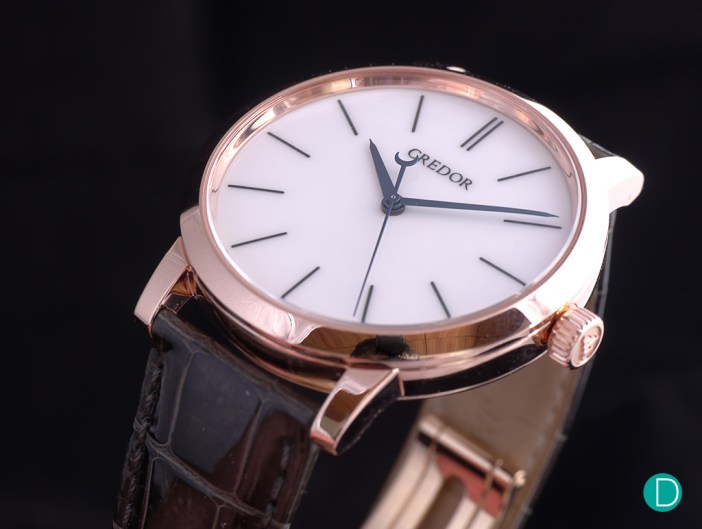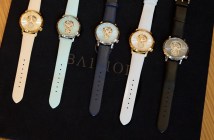Seiko Credor Eichi II in Rose Gold
“One of the finest watches in the world is not even Swiss” – such a statement would’ve shocked the world decades ago, but not today. In fact, we’re not talking about mainstream-level haute horlogerie. We’re referring to a watch that is Dufour-grade, the best of the best. In conjunction with the 10th anniversary of the Credor Spring Drive Eichi, Japanese powerhouse Seiko have introduced a new version of the landmark timepiece to the pantheon of high horology. Here, we bring you the details and our thoughts on the Credor Eichi II, now in rose gold.

The case, dial and hands
Previously made exclusively in platinum, the Eichi II is now also available in 18k rose gold. The dimensions of the case remain the same at an elegant 39.0 mm in diameter and 10.3 mm in thickness. Seiko uses the cold forging process to form the case of the new Eichi II. Unlike hot forging where extremely high temperatures are involved, cold forging occurs near room temperature where metal is forced into a die. Thanks to the greater density of the gold alloy created from cold forging, every surface shines more brilliantly and is more scratch-resistant. The surfaces are then Zaratsu polished, resulting in a mirror finish with a complete absence of any distortion.

The new rose gold case maintains the same dimensions as the original platinum Eichi II. At 39.0 mm x 10.3 mm, the watch pleases both the modern and classic crowd.
The dial that graces the rose gold Eichi II is identical to the one found in the original platinum version. The porcelain dial is almost 100% alundum, which yields a striking whiteness compared to traditional porcelain dials. It is delivered to Seiko’s Micro Artist Studio from an unnamed manufacturer in Nagoya. At the studio, the indices are hand-painted; the process is so tedious that only one dial can be completed in a day. In the platinum version, the paint used is blue in colour while in the new rose gold Eichi II, it is charcoal grey. We feel that sticking with the blue paint would’ve resulted in a more pleasing, consistent look, though admittedly we’re being really nitpicky here.

While the pristine porcelain dial isn’t manufactured by Seiko, it is hand-painted by the brand’s watchmakers (who have gone through painstaking training to be able to do so).
Under magnification, one can appreciate the contrast between the grainy texture of the paint and the smoothness of the dial. One can also see slight irregularities in the painting of the indices and marquee that would otherwise appear flawless to the naked eyes. These ‘imperfections’ have nothing to do with sloppiness. Rather, they are tell-tale signs of an artisan’s touch and dedication to tradition. The dial of the Eichi II is quite literally a work of art.

The hand-painted indices and scripts appear flawless from afar but small irregularities can be observed up close, signs of an organic, handmade dial.
The hands are crafted in steel and flame-blued by hand. The seconds hand is curved ever so slightly towards the end to reduce parallax error. Its smooth, gliding sweep round the dial is secondary to the spring drive movement within the watch. The crescent on the seconds hand serves not just as a counter-balance but also as a visual counterpoint to the straight lines of the three hands.

The blue of the steel hands look radiant against the stark whiteness of the porcelain dial. It is also complemented by the warmth of the rose gold case.
In a nutshell, the watch enjoys the best of both worlds: a contemporary design, achieved by largely traditional methods. Don’t let its plain look fool you, for it is in fact one of the more sophisticated dress pieces you’ll find in fine watchmaking.
The movement
The movement powering the Credor Eichi II in rose gold is none other than the Calibre 7R14. It is the same movement found in the platinum version, save for one minor aesthetic detail (more on it later). The Calibre 7R14 is a Spring Drive movement; we have previously explained the Spring Drive mechanism here and recommend that you give it a read. The 41-jewel, manually wound movement has a power reserve of 60 hours, indicated by a blued steel hand located movement side. It features a proprietary mechanism christened the ‘Torque Return System’ that leverages on the Spring Drive movement’s high torque. Normally, after the mainspring has been fully wound, the torque output is at its highest and approximately 30% of the available power is not needed to maintain the precision of the watch. This power effectively goes to waste in a normal movement. With Seiko’s patented Torque Return System, the energy is used to rewind the mainspring, resulting in a 25% increase in power reserve.

The Calibre 7R14, with an accuracy of +/- 1 second per day, as viewed through the exhibition case back.
No discussion of the Credor Eichi II is ever complete or legitimate without deliberating in length the finishing and decoration applied to the movement. The most eye-catching part of the movement is perhaps the mainspring barrel, skeletonised with a bell flower motif. The gap between the two large bridges form the ‘stem’ and the ‘leaves’ of the flower. The beveling on the movement is an art form in itself. Unlike most mainstream high-end watches, the chamfers are not merely flat polished surfaces but subtly convex with a perfectly regular width. They are also atypically wide – and stunning to behold. There are several beautifully executed outward angles, but no inward angles. The first Eichi’s two bridges featured several outward angles and one magnificent inward angle on each. This departure is interesting, as Seiko has shown that they have the capability, but chose not to include any sharp inward angles on the Eichi II.
The top surface of the bridges are not striped, which is something most have grown accustomed to. Rather, it is adorned with a linear brushed finish for a more austere look. The use of rhodium-plated brass for the bridges (as opposed to untreated maillechort in the first Eichi) also contributes to the sterile appearance that is in stark contrast to the organic front end of the watch. That said, the lack of striping does allow other elements like the flame-blued screws, the blue lacquer-filled engravings (gold-filled in the platinum version), and the in-house grown jewels to stand out.

Close up view of the skeletonised bell flower motif on the mainspring barrel. Numerous rounded and outward angles can be seen on it, though there are no inward angles.
The competitive landscape
The new Eichi II in rose gold is virtually the same watch compared to its platinum sibling save for the case material, the colour of the paint on the dial, and the colour of the filled engravings on the movement. Connoisseurs of the brand will be happy to learn that the rose gold Eichi II costs a not-insignificant 25% less than its platinum sibling at ¥4,300,000 before tax, equivalent to SGD52,114. From an aesthetics standpoint (the watch’s greatest selling point), the Eichi II is watch royalty. There aren’t too many timepieces in the world that are quite as artisanal as it.

The Credor Eichi II in rose gold looking ethereal on the wrist.
The Philippe Dufour Simplicity 37 mm is one such timepiece. Of particular interest is the dial: printed on the luscious white lacquered dial is the inscription “Metalem”, referring to the manufacturer that supplied the dial. Philippe Dufour lets Metalem print their name on the dial as an act of defiance to the usual practice of the industry keeping suppliers secret. Where things really start to heat up is when one examines the movement through the sapphire crystal case back. Of note is the beveling – they too are convex like in the Eichi II’s Calibre 7R14 (though not as wide). The number and sharpness of the outward AND inward angles in the Simplicity movement will drop the jaws of even the most seasoned enthusiasts. Further, the top surface of the bridges are adorned with the most impressive rendition of Geneva waves that you’ll ever see. Wide, billowing and evocative, they seem to almost cause the bridges to come alive. In our humble opinion, as incredible as the Calibre 7R14 is, the Simplicity movement has it beat convincingly in aesthetics. On the flip side, Seiko scores against Dufour on the watch front with its hand-painted porcelain dial.

The Philippe Dufour Simplicity. As Leonardo da Vinci once said: “simplicity is the ultimate sophistication”.

The masterpiece that is the movement of the Philippe Dufour Simplicity.
And then there’s Laurent Ferrier, a brand that is also known for its high finishing. The Laurent Ferrier Galet Regulateur features the brand’s three-piece “Montre École”, or “school watch” case. While the watch is also a three-hander like the Eichi II and Simplicity, it displays the time regulator-style (hour and seconds in sub-dials with central minutes). Where the Galet Regulateur really shines is in the beauty of its movement. Perhaps the most striking parts of the FBN Caliber 228.01 are the skeletonised balance cock and the micro-rotor bridge, both black polished to a spectacular sheen. Like the Simplicity, inward and outward angles can be found on the movement (though they aren’t quite as dramatic). It is also adorned with Geneva waves on the bridges which, again, is in stark contrast to the Eichi II’s brushed finish. The version of the Galet Regulateur shown in the pictures below is the Singapore Edition which is limited to 8 pieces and priced at SGD87,000.

The Montre École case is inspired from Mr. Laurent Ferrier’s actual school watch.

The stunning FBN Caliber 228.01 as viewed through the exhibition case back.
Concluding thoughts
The Credor Eichi II markets itself as a tantalising alternative to connoisseurs seeking an uber fine watch in this Swiss-dominated market. The new rose gold variant is in itself a warmer, better value-for-money version of the preceding platinum Eichi II. If one can look past the fact that it isn’t Swiss and is missing a balance wheel, one will find an extraordinary timepiece – perhaps even the catch of the century – in the rose gold Eichi II.





3 Comments
Sheer perfection. Almost makes a Patek look quotidian
I believe the dial manufacturer of the original Platinum is Noritake. Maybe they are still the ones making it for this one.
Thanks Albert. Yes the Eichi I had a dial made by Noritake. But the Eichi II is in-house. We have details of the dial manufacuture in our first Eichi II Platinum article.